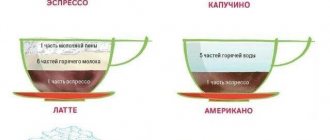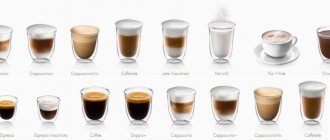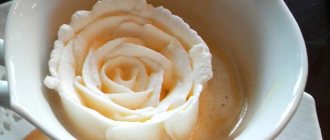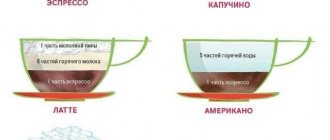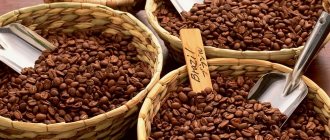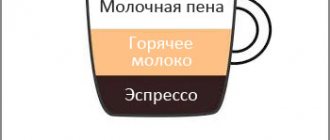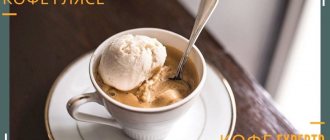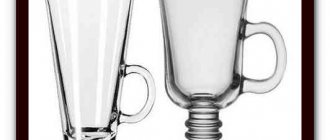Espresso
- the basis of most coffee-based drinks. The espresso itself is a treat for those who wholeheartedly love coffee in its pure form. In the classic version, it is a drink with a bitter taste and noble sourness, although the taste of espresso greatly depends on the type of coffee, the degree of roasting, the quality of the coffee machine and the skill of the barista. Espresso first appeared in Italy in 1901 when Luigi Pezzera patented the world's first coffee machine. Hot water at a temperature of 90-95 degrees under pressure of nine bars passed through a filter with finely ground coffee, absorbing its strength and aroma.
Description of the drink
The exact place and person who first began to combine two completely different products in one drink is unknown. It is generally accepted that the recipe for iced coffee originated in Austria, where it still remains one of the favorite drinks of the country's population.
Although, strictly speaking, the question of who actually invented glasse remains open to this day. There is a legend according to which a certain young Austrian, on a hot summer day, getting ready for an important business meeting, decided to run into a coffee shop to drink his favorite cappuccino. The bartender immediately got to work, rushing to serve a regular customer, but was displeased to discover that the milk, a necessary component for preparing the drink, had run out. However, the inventive barista found a way out of the situation by deciding to use ice cream instead of traditional milk.
The client liked the unusual drink with a great taste and enchanting aroma so much that from then on he began ordering it. Perhaps this legend explains the information that the mix consisting of coffee and ice cream was invented in Austria. Subsequently, the French adopted the recipe for making a cold cocktail, and they also gave it the name - glasse, which in French “glacé” means “frozen”, “ice”. By the way, the drink is so loved by coffee lovers that the popular color tone of Cies “Cold Glaze” is even named in its honor, which gives the hair a luxurious shade of blond with exquisite ash tints.
In the classic version, it is strong black coffee cooled to 10 ° C, to which creamy or vanilla ice cream is added. The standard serving is 100 g, but true drink lovers prepare it in much larger quantities.
It is believed that the ratio of black coffee to ice cream should be approximately 2:1, but in many recipes the share of ice cream is more often 25% of the total drink. The basis of the drink is espresso or Turkish. Even instant products are used in express recipes.
There are already more than 10 modern variations on the theme of glasse. It is even served hot.
The drink may include:
- cream or milk;
- alcohol;
- liquor;
- chocolate;
- spices;
- ice, etc.
This different combination of products makes the glass similar to other coffee drinks, such as latte or Viennese coffee.
Espresso is the right base for glace
The technological map “Black coffee with Glasse ice cream” indicates the following proportions of products:
- black coffee 75 g;
- ice cream “Plombir” 33 g;
- sugar to taste.
Serve in glass glasses or wine glasses with a handle. First, chilled coffee is poured, and then a scoop of ice cream is carefully placed. The drink must be served immediately before the ice cream dissolves. The calorie content of 100 g is 106 kcal.
Americano
In this section: Few people know about these properties of mirrors.
When you find out, you will be stunned! Top 6 foods to increase libido
There is no point in blaming work if there is no rest home
Five unforgivable mistakes in the kitchen
Family budget. Planning under sanctions
Partner news
espresso, half diluted with water. Unlike espresso lungo, the water in Americano does not pass through the coffee grounds, but is added later. As a result, the coffee is not as strong.
How to distinguish between latte and cappuccino
They are made from the same ingredients. However, special technologies allow you to get two different drinks.
Unlike latte, components for cappuccino are prepared separately. A classic espresso is prepared, and the milk is frothed using a cappuccino maker. The frothed milk is then added to the finished espresso.
When serving the latte, it is important that the layers do not mix.
The uniqueness of coffee drinks is that when identical ingredients are used, they end up differing not only in taste, but also in appearance. We described the difference between them in detail in the article “How cappuccino coffee differs from latte.”
Cappuccino (or cappuccino)
leader in popularity among coffee drinks. Delicate and at the same time strong cappuccino is loved all over the world. Many people mistakenly believe that it is prepared with cream. In fact, it is a drink based on espresso and milk.
There are many legends about the origin of cappuccino. According to one version, Italian monks of the Capuchin Order began preparing this type of coffee. Like all Italians, the monks were very fond of coffee. But in those days, coffee was banned by the church and was considered the drink of the devil. The Capuchins came up with a trick: he announced that white foamed milk gave the devil's coffee softness and sweetness, thereby removing sin. The monks whipped the milk by hand for a long time to get a tasty and beautiful foam. Of course, they also brewed coffee by hand - many centuries remained before the invention of special machines.
A modern cappuccino is prepared like this: a third of the espresso is poured into a porcelain cup, then the same amount of hot milk is poured. The top third of the cup is filled with milk foam, whipped with hot steam. A teaspoon is always served with a cup of cappuccino - first they use it to eat milk foam, and then drink the coffee itself.
Traditional iced glass recipe
You will need: water, ground coffee, ice cream (sundae, creme brulee or your favorite flavor). It is correct to prepare ground coffee in a special apparatus or coffee machine, but if you don’t have one, you can prepare instant coffee yourself and pour it into a prepared glass container: glass, wine glass, cup, glass and put 2 scoops of ice cream. Decorate with grated chocolate, cherry or cocoa powder, cinnamon, insert a straw and a coffee spoon. Before filling, cool the container by rinsing it with ice water .
Latte
translated from Italian means "milk". Indeed, there is more milk in this drink than in any other coffee. It differs from cappuccino, firstly, in its proportions, and secondly, in its preparation technology: when making a latte, coffee is poured into milk, and not vice versa. A cup of espresso is poured into the mass of frothed milk, and milk is poured on top again. Espresso is often served in tall glasses with a long ice cream scoop used to eat the foam.
Cappuccino and latte are an excellent canvas for practicing latte art - creating patterns on milk foam. In almost any cafe they will draw a twig, heart or leaf on the surface of your drink. At the latte art show, experienced baristas create real masterpieces on the surface of foamed milk.
What is the difference between a latte and an iced glass?
Latte and iced coffee cocktails are similar in many ways: they have a milder taste than standard coffee, contain milk in their recipe (in some versions of iced ice), and are similar in how the drink is served. Still, these are two different cocktails, differing both in the method of preparation and in the components included in their composition.
The latte is prepared on the basis of double espresso and frothed milk in proportions of 1 to 3. The milk is whipped until a thick, dense foam is formed using the cappuccino maker built into the coffee machine. You can read how to make a latte without a coffee machine here.
Glace is a coffee based on double espresso or Americano and ice cream in a 3 to 1 combination. That is, there is no milk in the traditional glace recipe. Ice cream replaces it. There are different ways to make ice cream that involves adding a small amount of milk to the coffee along with a scoop of ice cream.
Macchiato
not a specific type of coffee, but rather a certain way of serving it. This is the name given to a dot of espresso remaining on the surface of white foam, or, conversely, a drop of milk on the surface of black coffee. Therefore, “macchiato” can refer to both latte and espresso. Latte macchiato was originally prepared for children who wanted to drink coffee “like adults.” It was essentially warm milk with a splash of coffee added for flavor and color. Espresso macchiato is black, strong coffee with a speck of milk on the surface.
Short story
Rough coffee is prepared according to a special method. The base is espresso with the addition of heavy cream and vanilla sugar. The ingredients are mixed in a milk jug (pitcher) and whipped in a coffee machine. If everything is done correctly, the result is an airy mass with a rich taste.
It is important to achieve a uniform texture and delicate creamy taste. To create true rough, you must strictly follow the recipe.
It is called a coffee cocktail, with a luxurious presentation and a unique creamy vanilla foam.
This is the only coffee drink whose homeland is Russia. Its story began in 1996 in the Moscow Coffee Bean store. An experienced barista with an original imagination came up with an unusual recipe to satisfy the whim of a demanding customer. Now raf has many fans and is rightfully considered one of the most delicious.
Read more about this in the article “Raf coffee: what it is and how to prepare it.”
Frappe
a cold cocktail made from coffee, ice and milk, which is popular in warm Greece and Cyprus. Unlike mocha, it was invented in the mid-20th century. They say that at a coffee exhibition, an employee of one of the Greek companies did not find hot water and, in a panic, found a way to get foam on cold coffee. An accidental invention gave birth to a new drink. Coffee, sugar and a small amount of water are whipped in a mixer or shaker and then poured onto ice. Frappe coffee is served in a tall glass with a straw.
The tradition of drinking coffee with ice cream
Today, coffee with ice cream is called iced. The word comes from the French glace, which translates as ice or ice cream. Despite the origin of the name, Austria is considered the birthplace of the drink. Although there is another opinion, according to which it is believed that the Italians were the first to add ice cream to coffee. Be that as it may, the drink is incredibly popular all over the world today. You can enjoy its taste not only in a cafe, but also at home, because the ice cream is extremely easy to prepare.
Iced coffee: recipe. There are many options for preparing ice cream, here are the most popular:
- Classic ice cream recipe. Brew strong coffee, cool, then pour into a 250-300 ml glass glass. Add ice cream, which should be a quarter of the volume of the entire drink. You can use additives: grated chocolate, cinnamon, candy crumbs, nuts, coconut or cocoa powder.
- Glaze with ice cream and ice. Pre-prepare espresso with sugar (to your taste). Then pour the drink into glasses, where we add one or two ice cubes and a scoop of ice cream (vanilla or ice cream is best). Decorate the drink with grated chocolate or cocoa.
- Glass with ice cream. You will need: two egg yolks, 3 tablespoons of sugar, 50 grams of ice cream and, of course, coffee. First, brew strong coffee, beat the yolks with sugar and add to the drink. Place the resulting mixture in a water bath for 15 minutes, stirring occasionally. Pour the finished drink into glasses, leaving room for ice cream. For one glass you will need a ball of ice cream, which, if desired, can be decorated with chocolate syrup.
- Glaze with chocolate ice cream. This coffee does not need to be cooled; you can add ice cream immediately after brewing. The drink turns out very tasty with a couple of spoons of cognac or liqueur.
- Ice cream with candies and chocolate syrup. You will need: coffee (preferably strong), ice cream, cream, chocolate syrup and crushed candy. First, brew and cool the coffee, then whip the pre-chilled cream with powdered sugar. Place a ball of ice cream at the bottom of the glass and fill it with chocolate syrup. Pour in coffee in a thin stream and top the drink with whipped cream and crushed candies.
Compared to others
Espresso
The base for many coffee drinks is espresso. However, there are also lovers of this strong black coffee who drink it in its pure form. Classic espresso is served without milk and additional components that change the taste.
In terms of preparation time, espresso is prepared quickly – up to 30 seconds. Raf requires more attention to himself. The first stage requires the most time - mixing in the pitcher and giving the mass airiness.
Another difference is that espresso can invigorate you in one or two sips. He is most often chosen as a morning helper to wake up. Standard serving is in small coffee cups up to 25 ml. Raf is positioned as a relaxing cocktail with a large portion. It is preferred during the day or evening.
Interesting! Espresso coffee: what is it really?
Sugar is rarely added to espresso; it is intended for lovers of strong non-alcoholic drinks. It is suitable for those who love true black coffee with a bitter aftertaste.
At the same time, a mandatory ingredient in raf is vanilla sugar.
Lungo
Lungo is a classic espresso, but with the addition of a double portion of water. Cooking time - up to a minute. The standard serving size is 50 ml.
Ideally, it is drunk without milk or cream. Serve in a small cup. It's best to drink it during the day because a double dose of water makes it medium in strength.
Simple preparation and serving make lungo your everyday coffee. Raf is an evening cocktail and is rarely chosen as a morning invigorator.
Americano
The main rule of Americano is to serve the components separately to the guest. The main ingredient is classically brewed espresso, which comes in a larger cup. In a separate bowl - milk and hot water 70 ml. Addition: sugar. This allows the comefan to adjust the taste on his own.
Rough coffee has a subtle brewing method, and is served in one glass and in a complete variation. The guest should enjoy the delicate taste, and not experiment with the dosage of components.
Air cappuccino
Cappuccino takes second place in the ranking of types of coffee drinks. A coffee machine with a cappuccino maker pays for itself very quickly in any establishment. They love cappuccino for its tenderness and sophistication. It is vain to think that real cappuccino is prepared by mixing coffee with cream. The first cappuccino was made by combining black espresso with frothed milk. They say that Italian monks adored this type of coffee. A modern coffee machine with a cappuccino maker for cafes and other establishments will allow you to achieve excellent quality even with the largest influx of visitors. A good cappuccino machine produces thick and sweet foam, which lovers of this divine drink drink through a rim of coffee cream.
The main differences between cappuccino coffee and latte
Latte and cappuccino are quite different in taste. Latte has a refined coffee and milk flavor, while cappuccino has a rather strong coffee taste and rich aroma. Experienced coffee lovers are surprised that beginners quite often confuse these 2 drinks. Although the reason for the confusion is quite simple - the composition of the drinks, which includes coffee and milk. The same composition confuses many people who do not know that it is all a matter of proportions.
Key differences between latte and cappuccino
A lot can be said about the difference between cappuccino coffee and latte coffee. But so that the reader does not get confused, we will first highlight the main differences, and only then we will talk about the little things. So, the main differences between the drinks look like this:
- Definition. Cappuccino is defined as a subtype of coffee, and latte is defined as a coffee cocktail. Latte, like its derivative macchiato, is not a full-fledged variety of coffee.
- Proportions of ingredients. A cappuccino contains equal parts of espresso and milk, as well as whipped foam. If you do not take it into account, then the amount of coffee and milk is the same, so the coffee taste is felt brightly. A latte contains 1 part espresso and 2 parts frothed milk. It covers the taste of espresso, making it less noticeable.
- Cooking method. There are different types of lattes, but the classic version is prepared as follows. First, milk is poured into the cup, then espresso is added. The drink looks like it has two layers because the frothed milk has a higher density and does not mix with the coffee. Cappuccino, on the other hand, is created by mixing milk and coffee.
Important!
It is not recommended to prepare black coffee for lattes and cappuccinos in a Turk. This brewing method creates coffee that does not taste well with the whipped foam. It is better to brew in a coffee machine or coffee maker.
Different foam structure
Another difference between cappuccino coffee and latte coffee is milk foam. In cappuccino, milk is whipped until it is thick and thick. Experts unanimously say that the foam of a milk cappuccino can withstand a small heaped teaspoon of sugar. For latte, the situation is completely different. The frothed milk used for this drink has a fluffy and light texture. The milk in a good latte is like clouds and won't even hold a heaped spoon.
Based on this, we can say that the structure of the foam in cappuccino and latte is completely different. Unfortunately, in bad coffee shops this rule is not observed, and the differences between latte and cappuccino in such establishments are not very pronounced.
However, the milk foam of these 2 drinks also has common features. It should look uniform and have no air bubbles. If the foam contains too much air, it will become unsuitable for latte art. By the way, many people confuse cappuccino and latte precisely because the technique of drawing on cappuccino is also called latte art.
The pattern on a good cappuccino foam lasts about 12 minutes, for a latte – a little less. If the foam on the latte lasts 10 minutes, then that’s good. This is due to its cloud-based structure.
Difference in taste and aroma
When discussing how cappuccino differs from latte, one should not miss the taste and aroma properties. The taste of the latte is softer and more delicate, the aroma is more milky than coffee. Cappuccino has a brighter taste, which is only slightly smoothed out by milk, and its aroma is very rich and strong.
If you draw a scale with espresso on the left and milk on the right, then cappuccino is much closer to espresso in both taste and aroma. Latte, in turn, will be approximately in the middle of this scale. The aroma is a little closer to milk than to coffee.
In addition, cappuccino can have different strengths. It is possible to brew stronger espresso, and then the drink has a pronounced bitterness, despite the abundance of milk. Lattes use espresso of a certain strength and intensity. Pronounced bitterness is unacceptable.
Differences in serving
The way lattes and cappuccinos are served is another noticeable difference. Historically, it was customary to drink cappuccino very hot. Therefore, it is served in cups no larger than 180 ml - a small container retains heat longer and does not allow the drink to cool down. And for the ideal thickness of the foam layer, you need a cup that expands slightly upward.
Latte is a drink that has always been a morning drink. Therefore, it is served in a large bowl - at least 240 ml. The maximum volume is 360 ml, but there are other cases when the container reaches 400 ml. There are no requirements for the shape of the dish - it can either expand upward or be absolutely flat. Lattes are often drunk from glasses, but cups are more common.
As for additives and toppings, there is not much difference. Cinnamon, grated chocolate, and caramel are ideal for cappuccino and latte. A good topping for cappuccino and latte is liqueur, and for those who like something stronger, cognac is also suitable. But the most popular option is cinnamon. It favorably highlights the taste of milk and harmonizes with fairly strong espresso, making both drinks more interesting and rich in taste.
Conclusion
So, to easily distinguish a cappuccino from a latte, you don’t need to be a coffee sommelier. After the first sip, you can understand which note predominates in the taste of the drink - milk or coffee. Don't forget that a cappuccino is a full-fledged coffee with milk, and a latte is a milkshake with added coffee. This is their main difference.
It is worth paying attention to the structure of the foam. If you put a cup of latte and a cup of cappuccino next to each other, then anyone can easily distinguish the thicker and denser foam of a cappuccino from the airy structure of a latte.
Finally, there is one rule that many coffee shops follow. Lattes are served in original Irish glasses. In turn, cappuccino is served almost everywhere in small porcelain cups, which have an extended upward shape.
The following materials may also be useful to you:
Which is better, capsule or carob coffee maker Which coffee machine is better, capsule or grain What is better, capsule coffee or Turkish coffee How to choose a capsule coffee machine How capsule coffee is made How to use capsule coffee How to brew coffee without a Turk and a coffee maker How to clean capsule coffee machines Capsule coffee machines advantages and disadvantages How to brew coffee from capsules without a coffee machine How to use a capsule coffee machine Is capsule coffee harmful Which capsule or geyser coffee maker is better How capsule coffee machines work How to clean capsule coffee machines Which is better capsule or regular coffee maker Capsule coffee machines pros and cons Capsule coffee machines comparison of brands Composition of coffee in capsules What is coffee? in capsules The best way to preserve coffee Reusable capsules What is the difference between cappuccino coffee and latte coffee What is the difference between espresso and Americano Rough coffee recipe Freeze-dried coffee Rating of instant coffee Is instant coffee harmful The benefits and harms of coffee with milk Mochaccino coffee recipe Calorie content of coffee Which coffee grinder is better: manual or electric How to choose a coffee pot How to properly brew coffee at home in a Turkish pot on the stove How to drink coffee correctly How to whip milk froth for coffee How to brew coffee in a French press How to use a geyser coffee maker Empty capsules for a coffee machine
A little history
The dessert, which is coffee with ice cream, is called... surprisingly, heated debate still continues on this issue. There are several spelling variants in the Russian language - “glace”, “glace”, “coffee-glace” and “coffee glace”. Some argue that the last option is truly literate, others object. As a result, most linguists agree that any variation of the name is correct. However, from this the look still remains unchanged since the end of the 19th century or the beginning of the 20th.
- Don't miss: Types and names of coffee drinks
Oddly enough, the history of the origin of the drink is also shrouded in mystery and is based only on assumptions.
Some consider France to be its homeland, others – Austria. It’s just that the word “glacé” is translated from French as “icy, frozen,” so most are inclined to the first option. Supporters of the second version indignantly argue that the drink was created in Austria, where it did not gain much popularity, but was later appreciated by the French. By the way, in the word “glace” the stress falls on the last syllable, in the French manner. The circumstances of the creation of the drink also remained a mystery, but there is a popular legend on the Internet about an inventive cook who did not have milk on hand, and instead added ice cream to a macchiato for a hurrying visitor, who was delighted with the resulting drink.
Turkish coffee at home
In full screen
The best Turk for making oriental coffee is a copper one with a thick bottom. First, heat it so that the beans “open”, then add ground coffee in the proportion of 1 tsp. per 100 ml of water, although it all depends on your taste preferences. Add sugar and spices, pour cold water over the coffee and heat over low heat until foam appears. Wait for the foam to rise to the maximum, and immediately remove the Turk from the heat without waiting for the coffee to boil - this will hopelessly ruin its taste. Repeat heating several times, then pour the coffee into heated cups. When brewing Turkish coffee, you should absolutely not stir it!
Arabs prepare coffee a little differently. First, they throw sugar into the Turk, melt it over the fire, pour in cold water, bring it to a boil, and only then add ground coffee. Next, the Turk is heated over low heat until foam appears, after which the foam is removed without stirring the coffee and poured into cups. After this, the finished coffee is poured into cups directly onto the foam cap. The French add sugar to the Turk only after foam appears, stir the coffee until the sugar is completely dissolved and remove from the heat a couple of seconds before boiling. Among all the homemade coffee recipes, Turkish coffee is the most invigorating, deep and rich.

